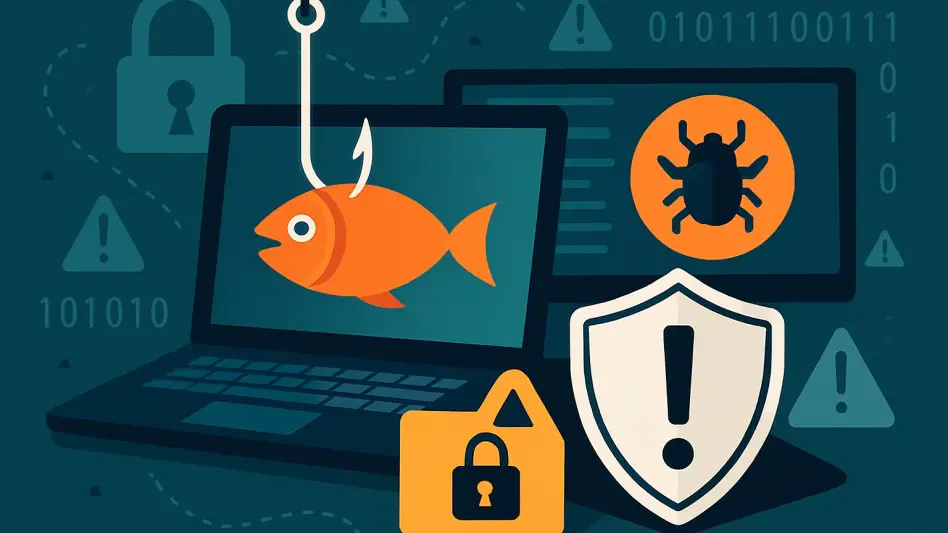In an era where digital communication serves as the backbone of professional networking, a disturbing trend has emerged that preys on the aspirations of job seekers, with cybercriminals crafting sophisticated phishing scams disguised as enticing job offers from reputable companies like Google. These scams target unsuspecting users of platforms such as Google Workspace and Microsoft 365, often sending fraudulent emails to corporate addresses to steal sensitive login credentials by luring recipients with the promise of a dream career. The deceptive nature of these scams, combined with their ability to adapt and evade detection, poses a significant threat to individuals and organizations alike. As these attacks grow in complexity, understanding their mechanisms and staying vigilant become paramount for anyone navigating the online job market.
Unmasking the Phishing Tactics
How Scammers Craft Deceptive Emails
The foundation of this scam lies in the art of deception through carefully designed emails that mimic legitimate correspondence from Google Careers. These messages often start with a casual yet engaging hook, such as a simple question about the recipient’s availability for a conversation. Sent in multiple languages like English, Spanish, and Swedish to cast a wider net, the emails use varied sender names and addresses, such as “GG Careers,” to appear authentic. What makes these attacks particularly insidious is the scammers’ knack for adapting their approach, tweaking content and delivery methods to slip past email security filters. This constant evolution underscores the challenge of staying ahead of cybercriminals who exploit trust and urgency to manipulate their targets into taking action without a second thought. The scale of these campaigns reveals a calculated effort to infiltrate corporate environments where sensitive data is often just a click away.
Exploiting Trusted Platforms for Credibility
A striking feature of these phishing attempts is the use of legitimate services to bolster their credibility and bypass suspicion. Scammers leverage trusted platforms like Salesforce and Recruitee to send their fraudulent emails, while hosting malicious links on newly registered domains through providers such as NiceNIC and Porkbun. This strategic abuse of recognized names adds a veneer of authenticity, making it harder for even cautious recipients to spot the fraud. Once a victim clicks on a link—often labeled with an inviting prompt like “Book a Call”—they are led through a series of deceptive steps, from a fake Cloudflare Turnstile verification page to a counterfeit scheduling interface mimicking Google’s branding. The final destination is a fabricated login page designed to harvest usernames and passwords. This multi-layered trap showcases the lengths to which attackers go to create a convincing illusion, exploiting familiar digital ecosystems to lower defenses.
Safeguarding Against Evolving Threats
Decoding the Evasion Techniques
One of the most alarming aspects of these scams is the subtle yet effective methods used to dodge security scanners meant to protect users. Cybercriminals employ coding tricks, such as breaking up recognizable phrases like “Google Careers” by embedding each letter within separate HTML label elements. This fragmentation prevents automated systems from flagging the content as malicious, allowing the emails to reach inboxes undetected. Advanced detection engines, like those developed by cybersecurity experts, have started to counter these tactics by focusing on indicators such as links tied to domains registered within the last 30 days. Such innovations highlight the critical role of cutting-edge technology in identifying and mitigating risks. However, the adaptability of these phishing campaigns means that security measures must continuously evolve to keep pace with the ever-changing strategies employed by attackers.
Building a Culture of Online Vigilance
Beyond technological defenses, fostering a mindset of skepticism and verification is essential in combating these sophisticated scams. The rising tide of recruitment-themed phishing attacks, as noted by various cybersecurity firms, reflects a broader trend of cybercriminals targeting professional aspirations. Individuals must be encouraged to scrutinize unexpected job offers, verifying the authenticity of communications before engaging with links or sharing personal information. This vigilance is particularly crucial in corporate settings where a single breach can compromise vast amounts of sensitive data. Educational initiatives and training programs can play a pivotal role in equipping employees with the skills to recognize red flags, such as unusual email addresses or urgent calls to action. As phishing threats grow more dynamic, combining human awareness with robust security tools offers the best chance to thwart these cunning attacks and protect valuable credentials.
Final Reflections on Cyber Defense
Looking back, the detailed exposure of these fraudulent job offer scams revealed a calculated effort by cybercriminals to exploit trust through meticulously crafted emails and the misuse of legitimate platforms. The persistent adaptation of their tactics, from coding tricks to multi-step traps, demonstrated a level of sophistication that challenged both users and security systems. This episode served as a stark reminder of the risks hidden within everyday digital interactions, especially in professional environments. Moving forward, the emphasis must remain on proactive steps—verifying suspicious communications, staying updated on emerging threats, and investing in advanced cybersecurity solutions. By cultivating a habit of caution and leveraging innovative tools, individuals and organizations can build stronger defenses against the relentless evolution of online fraud, ensuring safer navigation of the digital landscape.








